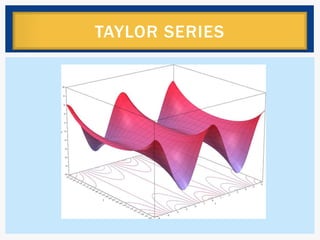
Taylor
- 2. Taylor's Series is based on the fact that, if a function is continuous and differentiable, The value of that function a small distance, h, from point x will be equal to the value of the function at x, plus a "fudge factor," or really a series of fudge factors. This is stuff you should know, because it is used extensively in math, physics, and geophysics. Taylor's series can be written in several forms. The first is: TAYLOR SERIES
- 3. It includes the residual term to consider all terms from n +1 to infinity The Taylor Series is a representation of a function as an infinite sum of terms calculated from the values of its derivatives at a single point. If the series is centered at zero, the series is also called a Maclaurin Series. TAYLOR SERIES
- 4. The greater amount of n-terms are included the better the approximation of the true solution. It is common practice to use a finite number of terms of the series to approximate a function.
- 5. Exponential Function (in blue), and the sum of the first n+1 terms of its Taylor series at 0 (in red).
- 6. The practical value of the Taylor series is the use of a finite number of terms that give a close enough approximation to the true solution. The decision on how many terms are required to obtain a reasonable approximation is based on the residual term of the expansion Taylor series and truncation errors
- 7. The terms of the series that are neglected as waste, which depends on two factors: 1. The number of terms in the series (n), since the higher the value of n, the less waste and better the approximation to the value of the function. 2. The step size or distance between the value of the variable (h) because the lower the value of h, the greater the proximity between xi and xi +1 and thus, the better the approximation to the value of the function. Taylor series and truncation errors It represents the next step for the approximation series
- 8. Example Numerical Simulation applied to the reservoir. The use of Taylor series are the starting point for numerical differentiation of a simulation model.
- 9. Example.
- 10. Example To view the usefulness of Taylor series, Figures 1, 2, and 3 show the 0th-, 1st-, and 2nd-order Taylor series approximations of the exponential function f(x) = ex at x = 0. While the approximation in Figure 1 becomes poor very quickly, it is quite apparent that the linear, or 1st-order, approximation in Figure 2 is already quite reasonable in a small interval around x = 0. The quadratic, or 2nd-order, approximation in Figure 3 is even better. We will use Taylor series for two purposes: To linearize a system, using the 1st-order Taylor-series approximation, and to perform error analysis on numerical method.
- 11. Figure 1. The zeroth-order Taylor series approximation of ex around x = 0.
- 12. Figure 2. The first-order Taylor series approximation of ex around x = 0.
- 13. Figure 3. The second-order Taylor series approximation of ex around x = 0.
- 14. BIBLIOGRAPHY CHAPRA, Steven C. y CANALE, Raymond P.: Métodos Numéricos para Ingenieros. McGraw Hill 2002. Schlumberguer Floviz-Eclipse 2008.1 http://demonstrations.wolfram.com/TaylorApproximationsInTwoVariables/